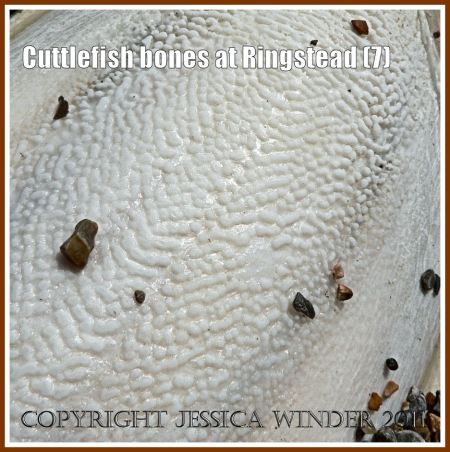Not many people realise that the familiar white cuttlebones they see on the beach or in the birdcage are in fact molluscan seashells. The hinged shells of bivalves, and the coiled shells of gastropods, enclose the body of the animal but the cuttlebone of the cephalopod mollusc known as the Common Cuttlefish, Sepia officinalis Linnaeus, is the remnant of a shell, contained internally within the soft body.
The photograph above shows a cuttlefish bone on kelp at Ringstead Bay, Dorset. The cuttlebone is elongate-oval, bi-convex, very light-weight, and mostly calcareous or chalky. There is a thin horny extension like a shelf around the edges of the bone; this becomes larger and forms a curved hood at the rear end of the bone. The under-surface shown in this picture has a slightly flaky and powdery texture.
In the living cuttlefish, the bone is embedded in the fleshy mantle on the upper surface of the body. Cuttlefish are related to the octopus which have no shell at all; to the squid which have a narrow thin internal ‘pen’; and to the nautiloids which have a large external, coiled shell that acts as a buoyancy aid. Nautiloids are the nearest living species to the Ammonites that are found only as fossils today. All of these free-swimming molluscs have in common a large brain and head with a beak-like mouth surrounded by tentacles or arms.
The cuttlebone helps to stiffen the body like a skeleton. It is also a float. The front end is filled with gas most of the time to counteract the heavy weight of the body and tentacles, while the rear end of the bone is filled with liquid. This is the way the cuttlefish maintains neutral bouyancy in the water and is able to swim on the level. The ratio of liquid to gas in the cuttlebone is governed by the degree of light perceived by the eyes. During daylight, cuttlefish stay near the seabed by increasing the amount of liquid in the bone. At night, the cuttlefish increase the amount of gas in the bone so that they can swim nearer to the sea surface where they feed on other organisms that also rise through the water column when it gets dark.
The picture above shows in close-up the rear end under-surface of the cuttlebone with its delicately sculptured horny extension. Within the living animal, this thin layer curves down over the rear end within the fleshy mantle. Continuous growth of the cuttlebone is initiated here.
I was fascinated to also find the unusually marked cuttlebone shown above on the shingle at Ringstead. It looks as if, at some stage in its life, the bone had been virtually broken in half but that it had healed and the animal survived. Perhaps it had sustained this substantial damage from a predator trying to bite through it?
In addition to the apparently healed break, blue and black stains have formed an interesting design on the cuttlebone. In the picture below you can see this gently iridescent pattern in close-up. It highlights details of the structure of the cuttlebone. A series of fine lines is revealed. I think that the injury to the cuttlefish may have lead to a leakage of the fluid from the ink sac into the bone.
The cuttlebone is actually constructed from a series of layers and chambers. The fine, slightly harder septa equate to the septa that divide the the coiled external shell of nautiloids and ammonites into buoyancy chambers. Between each dividing septum, fragile, crystal columns support the chambers. You can just make out this building plan from the cross-section shown below.
The picture below gives a general view of a different cuttlebone. This one is part buried in the shingle with the upper surface in view. The upper surface is hard and glossy in contrast to the more powdery and soft lower surface. It is also distinguished by the wart-like papillae that decorate it. There is a close-up of this knobbly pattern as well.
The living Common Cuttlefish is a wonderful-looking sea creature. If you would like to see one swimming in the sea, click here for some video clips and pictures on the ARKive website.
Better still, you can have a look for live cuttlefish yourself on the Purbeck Marine Wildlife Reserve at Kimmeridge Bay, Dorset where they have laid down a Snorkelling Trail with old lobster pots for cuttlefish to lay eggs in.
Revision of a post first published 31 May 2010
COPYRIGHT JESSICA WINDER 2011
All Rights Reserved








A fascinating commentary on a commonly-seen object!
Great deductive work on the broken shell too…..I’ll look closer at cuttlefish from now on.
LikeLike
Thank you, Steve. I am always curious about the way things have become the way they are. I try to weigh up all the evidence but sometimes the deduction remains speculative.
LikeLike
So much to see in looking closely–and in knowing what you’re looking at, I must add. The image with the leaking ink had a special charm for me.
LikeLike
Sometimes the beauty lies in the detail. I don’t always instantly understand what I am looking at but I have lots of books to which I can refer.
LikeLike